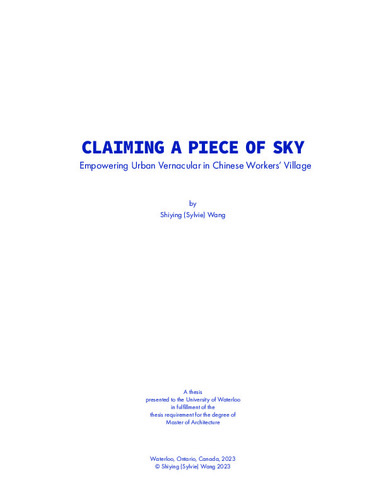| dc.description.abstract | When you wander into a workers’ village on the outskirts of Shanghai, China, you would see a very unique type of urban vernacular: suspended additions hanging on the façade. They are the inhabitants’ attempt to transform the adverse spatial situations of the socialist-style workers’ village and to create a viable form of life in contemporary Shanghai by privatizing the public space, even the one in the sky.
Through texts, maps, photographs and illustrations, this thesis explores, documents and develops an understanding of both the mechanisms and physical characteristics of those urban vernacular spaces, to showcase inhabitants’ ingenuity in creating innovative spatial praxes as well as their political agenda in seeking a voice within the state-controlled renewal process. It is in this context that this thesis seeks opportunities to re-imagine a inhabitants-led renewal in Tianlin second villages and asks: how can architects turn the political and spatial agency of inhabitants into constructive catalysts and to empower the inhabitants to design, construct and modify their unique extension to suit their current and future spatial needs. In addition, how can the design build upon the existing innovative spatial praxes and further encourage corridor social interaction to dissolve social barriers between different groups.
This thesis proposes to modify the existing two-stage consultation renewal process into a two-stage co-governance renewal model, influenced by the open building theories of the Dutch architect John Harbraken. As a first stage, “the support” entails establishing a regulatory framework that is negotiated and communicated between residents and authority. In the second stage, “the infill”, each inhabitant can fully engage in the design and construction of their own addition within the framework established in the first stage. There are two systems that facilitate the infill process: the “we-design” toolkit and the “we-build” kit-of-parts. The “we-design” toolkit is an assemblage of physical modular blocks designed to unlock the fine-grain spatial agency of autonomous individuals. Similar to an Ikea furniture, the “we-build” kit-of-part features an easy assembly and disassembly process that allows the inhabitants to claim a piece of sky by themselves. | en |

